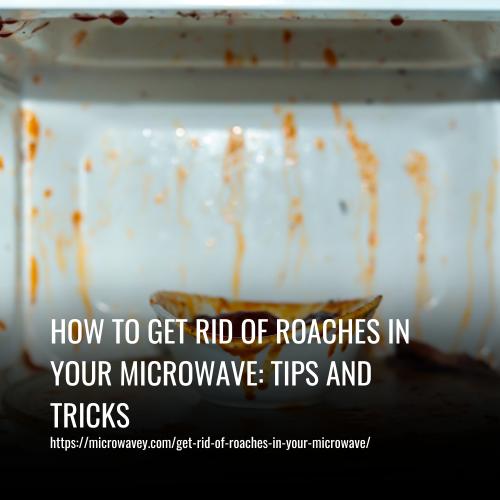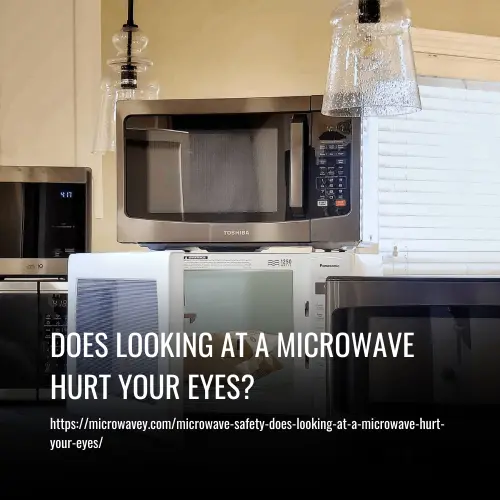To get rid of roaches in your microwave, start by deep cleaning the interior and exterior of the microwave. Use bait and dust traps, which are safe to use around microwaves, to trap the roaches. Avoid using pesticides, as they can damage the microwave.
Carefully examine every crevice of the microwave for roaches, as they can hide in small spaces. Roaches can infest microwaves through constant use, but it’s not difficult to remove them. To ensure a roach-free microwave, it’s important to use safe and effective methods, such as traps, and to thoroughly clean the appliance.
To Get Rid of Roaches in Your Microwave, follow these Tips:
- Clean the Microwave Thoroughly.
- Use Roach Bait.
- Use Boric Acid.
- Seal Any Cracks or Holes.
- Keep Your Kitchen Clean.
- Use Essential Oils.
- Call a Professional Exterminator.
- Prevent Future Infestations.

Get Roaches Out Of Microwave
If you’ve discovered roaches in your microwave, it’s important to take immediate action to eliminate the pests and prevent them from contaminating your food. Roaches can carry harmful bacteria, so it’s crucial to get them out of your microwave as soon as possible.
Here are some effective methods to help you rid your microwave of these unwanted visitors:
1. Clean the Microwave Thoroughly:
To clean the microwave thoroughly, start by removing any removable parts such as the turntable and wipe them clean with warm, soapy water. Next, mix equal parts water and white vinegar in a microwave-safe bowl and place it in the microwave.
Heat the mixture on high for 5 minutes until steam forms on the walls. Let it sit for another 2-3 minutes to allow the steam to loosen any food splatter. Carefully remove the bowl using oven mitts and wipe down the interior of the microwave with a damp cloth or sponge. Pay extra attention to any stubborn spots, and use a scrubbing pad if necessary.
For the exterior, wipe down with a multi-purpose cleaner and a microfiber cloth. Finally, dry all the parts thoroughly and reassemble the microwave. This thorough cleaning method will remove any lingering odors and ensure a clean and sanitary microwave for your next use.
2. Use Roach Bait:
Roach bait is a type of pesticide that comes in the form of gel, bait stations, or bait traps. It is designed to attract and kill cockroaches. The bait contains a slow-acting poison that the roaches consume and then bring back to their nest, which ultimately eradicates the entire colony.
To use roach bait, simply place the bait stations or traps in areas where roaches are commonly found, such as behind appliances, under sinks, or in dark, hidden areas. It is important to follow the manufacturer’s instructions for placement and quantity of bait.
Roach bait is an effective and convenient method for controlling roach infestations, as it targets the source of the problem and can continue to work for several weeks after initial placement. Always keep roach bait out of reach of children and pets, and be sure to regularly check and replace the bait as needed.
3. Use Boric Acid:
Boric acid is a white, crystalline chemical compound that is used for various purposes. It is often used as an insecticide, fungicide, and as a flame retardant. Insecticides containing boric acid are commonly used to control cockroaches, ants, and other pests. It works by disrupting the insect’s digestive system and affecting its metabolism, ultimately leading to its death.
Boric acid can also be used as a treatment for yeast and fungal infections, as it has antiseptic and antifungal properties. Additionally, it is used in some skincare products for its mild antibacterial and antifungal effects.
Furthermore, it is also used in the production of fiberglass, textile fibers, and as a component in some enamel glazes.
When using boric acid, it is important to follow safety precautions, as it can be toxic if ingested in large amounts. It should be used in well-ventilated areas and kept out of reach of children and pets. Overall, boric acid is a versatile chemical compound with a wide range of applications.
4. Seal Any Cracks or Holes:
To seal any cracks or holes, use a caulking gun or weatherproof sealant to fill in any gaps or openings in walls, windows, doors, or other areas where air and moisture can enter or escape. This will help improve energy efficiency and prevent water damage and pests from getting into your home.
5. Keep Your Kitchen Clean:
Keeping your kitchen clean is essential for maintaining a hygienic and safe food preparation environment. To keep your kitchen clean, follow these steps:
- Clean up spills immediately to prevent bacteria growth and slips.
- Wash dishes and utensils promptly to avoid the buildup of dirt and bacteria.
- Wipe down countertops and surfaces with a disinfectant regularly to prevent the spread of germs.
- Sweep and mop the floors to remove food and debris, reducing the risk of pests and bacteria.
- Regularly clean appliances, such as the oven, microwave, and refrigerator, to prevent the buildup of bacteria and contamination of food. By following these simple steps, you can ensure a clean and safe kitchen environment for you and your family.
6. Use Essential Oils:
Essential oils are concentrated extracts from plants that are often used for their healing and therapeutic properties. To use essential oils, you can add a few drops to a diffuser to release the aroma into the air, mix them with a carrier oil for a soothing massage, or add them to bathwater.
Some common essential oils and their benefits include lavender for relaxation and stress relief, peppermint for headache relief, and tea tree for its antibacterial properties. When using essential oils, it’s important to always dilute them properly and perform a patch test to check for any potential skin allergies.
7. Call a Professional Exterminator:
When dealing with a persistent roach infestation, it is best to call a professional exterminator. They have the expertise to identify the source of the roaches and effectively eliminate them from your home.
Additionally, they can provide advice on how to prevent future infestations, giving you long-term relief from these pests. If all other methods have failed, bringing in a professional is the most effective solution to address a roach problem.
8. Prevent Future Infestations:
To prevent future infestations of roaches in your microwave, it is important to practice proper kitchen hygiene. This includes regularly cleaning and sanitizing your appliance, storing food in sealed containers, and immediately wiping up any spills or crumbs. It is also important to inspect any packages before bringing them into the house, as roaches can often hitchhike inside of them.
By following these steps, you can effectively prevent roaches from infesting your microwave without having to resort to using harsh chemicals or expensive treatments.
How Do You Get Rid Of The Nasty Cockroach Smell In The Microwave?
If you’ve ever had a cockroach infestation in your kitchen, then you know how unpleasant the lingering smell can be, especially in your microwave. The odor can be difficult to get rid of, but with the right techniques, you can eliminate the nasty cockroach smell and have your microwave smelling fresh and clean once again.
Here are some effective methods to help you get rid of the unpleasant odor in your microwave:
1. Vinegar Solution:
To eliminate the cockroach smell in your microwave, create a vinegar solution by mixing equal parts of white vinegar and water in a microwave-safe bowl. Place the bowl in the microwave and set it to run for 5-10 minutes, depending on the severity of the smell.
After the time is up, carefully remove the bowl and wipe down the inside of the microwave with a clean cloth. This simple and effective method harnesses the powerful cleaning properties of vinegar to eliminate unpleasant odors in your microwave.
2. Baking Soda Solution:
To use baking soda to absorb unpleasant odors in the microwave, mix a tablespoon of baking soda with a cup of water in a microwave-safe bowl. Place the bowl in the microwave and set it to run for 5-10 minutes.
After the time is up, carefully remove the bowl and wipe down the inside of the microwave with a clean cloth. This solution helps to eliminate odors and freshen up the interior of the microwave.
3. Lemon Juice Solution:
To eliminate the cockroach smell in your microwave, you can use a simple lemon juice solution. Start by mixing the juice of one lemon with a cup of water in a microwave-safe bowl. Place the bowl in the microwave and set it to run for 5-10 minutes.
After the microwave has finished running, carefully remove the bowl and wipe down the inside of the microwave with a clean cloth. This method is effective in getting rid of the unpleasant odor left behind by cockroaches.
4. Activated Charcoal:
Activated charcoal is an effective natural odor absorber that can help eliminate cockroach smell from your microwave. To use this solution, place a few pieces of activated charcoal in a microwave-safe bowl and place it in the microwave. Set the microwave to run for a few hours or overnight, depending on the severity of the smell.
Once the time is up, remove the bowl and dispose of the charcoal. This method helps to neutralize and eliminate the unpleasant odor, leaving your microwave smelling fresh and clean.
5. Use Odor-Eliminating Products:
If previous remedies do not eliminate the unpleasant smell from your microwave, consider using odor-eliminating products. There are commercial products designed specifically to eliminate odors, and it is important to look for ones that are safe to use in microwaves.
Follow the instructions on the product carefully, and make sure to not leave any residue behind. This can help effectively remove any lingering smells and leave your microwave smelling fresh and clean.
6. Professional Cleaning:
If the solutions mentioned before have not been effective in eliminating the cockroach smell from your microwave, it may be time to consider hiring a professional cleaning service. Professional cleaners have the necessary equipment and expertise to thoroughly clean your microwave and get rid of any lingering odors. This can be a daunting task, but it is possible with the help of professionals.
Additionally, it is important to keep your kitchen clean and regularly clean your microwave to prevent cockroach infestations in the future.
FAQs
To eliminate cockroaches in your microwave, start by cleaning the inside with warm water and dish soap to remove any food particles attracting the roaches. Set traps around your home using baits or liquids designed for cockroach elimination. If these methods fail, seek professional pest control assistance.
Yes, you can use a diluted bleach solution to neutralize odors and disinfect the appliance. Mix one part bleach with four parts water, clean the interior, rinse with warm water, and leave the door open for a few hours before using it again.
Cockroaches are insects that are divided into peridomestic roaches, which migrate inside when it’s cold, and domestic roaches that live in human homes year-round.
Yes, microwaves can attract cockroaches due to their warm and humid environment, as well as food particles accumulating inside. Practicing proper kitchen hygiene and using cockroach traps can help prevent infestation.
Yes, roaches can infest a microwave if proper sanitation and hygiene are not maintained. Immediate cleaning of spills, storing food in airtight containers, sealing entry points, and using cockroach traps can prevent infestation.
No, vinegar should not be used in the microwave to get rid of roaches, as it can cause damage and is ineffective. Instead, focus on proper kitchen hygiene and sealing entry points to prevent infestation.
Conclusion:
Dealing with roaches in your microwave can be a frustrating and unsanitary issue. This article provides practical tips and tricks for effectively getting rid of roaches in your microwave, such as using natural repellents like peppermint oil, keeping the microwave clean and dry, and sealing up any entry points.
By following the advice in this article, readers can ensure that their microwave remains free from roaches and the potential health hazards they bring. Additionally, the tips and tricks offered are affordable and accessible to everyone, making it easier for individuals to take action and resolve this problem.


